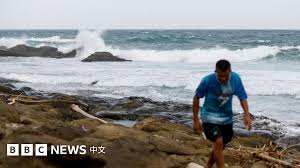As Typhoon Ragasa continues to advance from the Luzon Strait towards the South China Sea, the impact of this powerful storm is being felt across various regions, prompting authorities to take precautionary measures. With its eye moving in a northwest direction just north of Luzon Island in the Philippines, Ragasa has prompted calls for wind prevention measures in mainland China, Hong Kong, and Macau, with concerns mounting about its strength potentially rivaling previous powerful typhoons like 2024's Mogao and even 2017's Hato.
In Taiwan, the outer bands of Ragasa have started affecting the southern and eastern regions, leading to some counties and cities issuing work and school suspension orders. Mainland China and Hong Kong meteorological departments forecast strong impacts along the southern coast until Wednesday, with Guangdong planning to evacuate hundreds of thousands of people. Hong Kong authorities have raised the typhoon signal to No. 8 on Tuesday afternoon, announcing two days of school closures and expectations of flight cancellations at the airport. Macau is urging residents to stock up on supplies for three days.
Meteorological predictions indicate that Ragasa is expected to make landfall on the western coast of Guangdong on Wednesday, followed by a westward trajectory towards Vietnam's northern region after briefly returning to the northern waters of the Gulf of Tonkin.
Notably, the Central Meteorological Observatory of China reported that Ragasa's maximum winds near its center reached up to 62 meters per second on Monday morning, surpassing the force of a Category 4 hurricane in the U.S. This super typhoon is anticipated to enter the South China Sea with peak intensity comparable to the 2024 Typhoon Mogao, posing high disaster risks to the northern region and South China.
Authorities in various regions are taking proactive measures to ensure public safety. Guangdong Province raised its emergency response level to the second-highest "major" level, relocating over 10,000 ships to suitable waters for shelter. Shenzhen, adjacent to Hong Kong, is planning to evacuate and accommodate around 400,000 residents, including those in covered living areas, low-lying zones, and coastal areas.
Moreover, mainland China's China Railway Guangzhou Bureau Group announced the suspension of all high-speed and conventional trains in Guangdong Province throughout Wednesday. These combined efforts underscore the extensive preparations being made to safeguard lives and property in anticipation of the super typhoon's landfall and subsequent impacts.
In the face of this imminent threat, schools, businesses, transportation services, and commercial activities are being suspended across multiple cities in preparation for the approaching storm. Cities like Zhuhai, Jiangmen, Yangjiang, and other regions have collectively announced the implementation of the "five suspensions" strategy encompassing halting of classes, work, production, transportation, and business operations in the wake of Typhoon Ragasa.
Public transport services, including flights and ferry services, are being significantly disrupted and canceled, affecting a wide range of locations across Hong Kong, Macau, Guangdong, and beyond. Airlines like China Southern Airlines, Cathay Pacific, and Hong Kong Airlines have unveiled flight cancellation plans, with hundreds of flights being impacted.
As regional authorities brace for the impact of the super typhoon, residents are advised to stay informed about weather updates, follow safety directives, and take necessary precautions to mitigate potential risks. Vigilance and preparedness are crucial during these challenging times to ensure the well-being and safety of all individuals in the affected regions.
In conclusion, the coordinated efforts and stringent measures being implemented across various regions highlight the urgent response to the imminent threat posed by Typhoon Ragasa, emphasizing the importance of prioritizing public safety and preparedness in the face of natural disasters.

